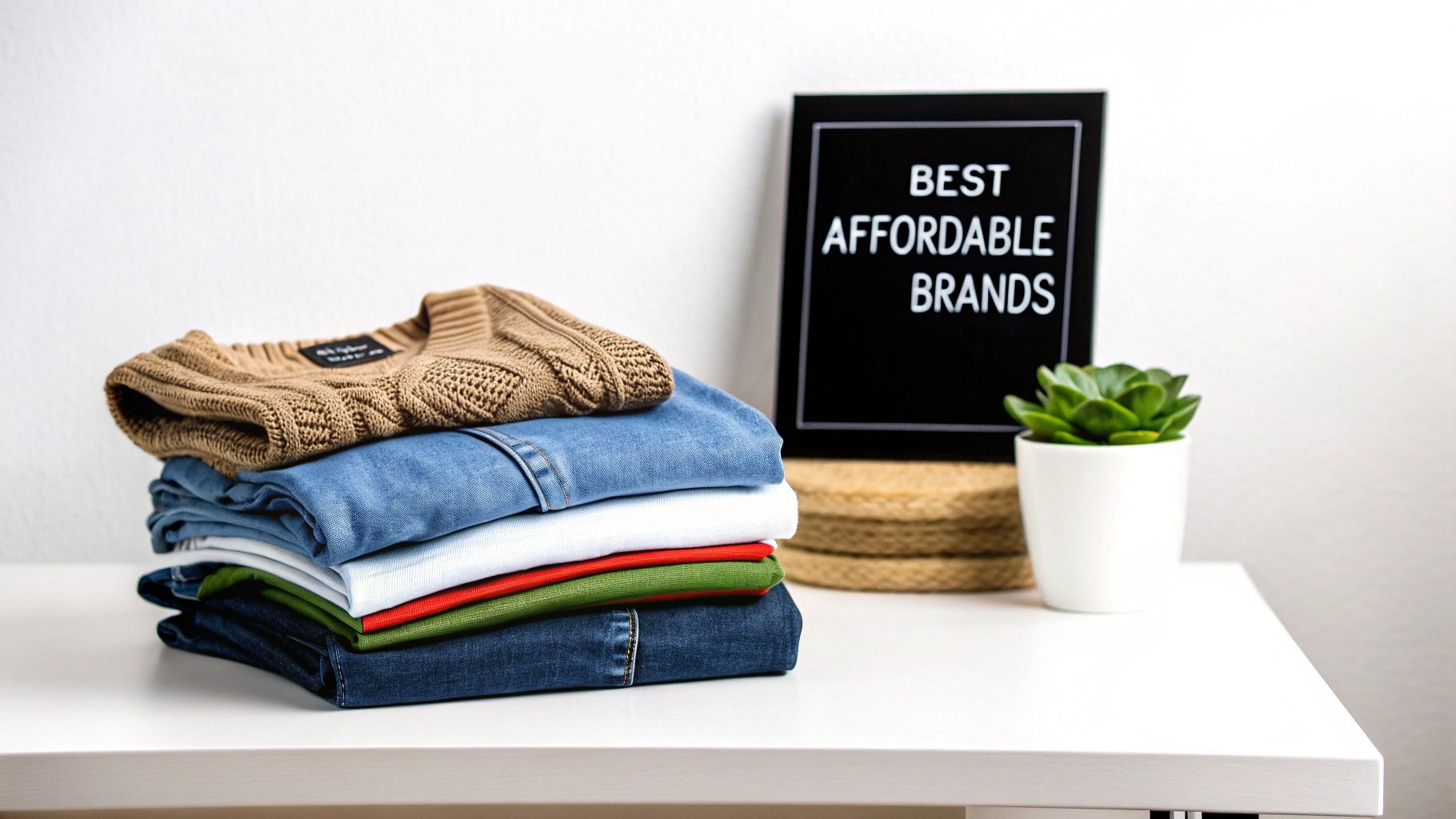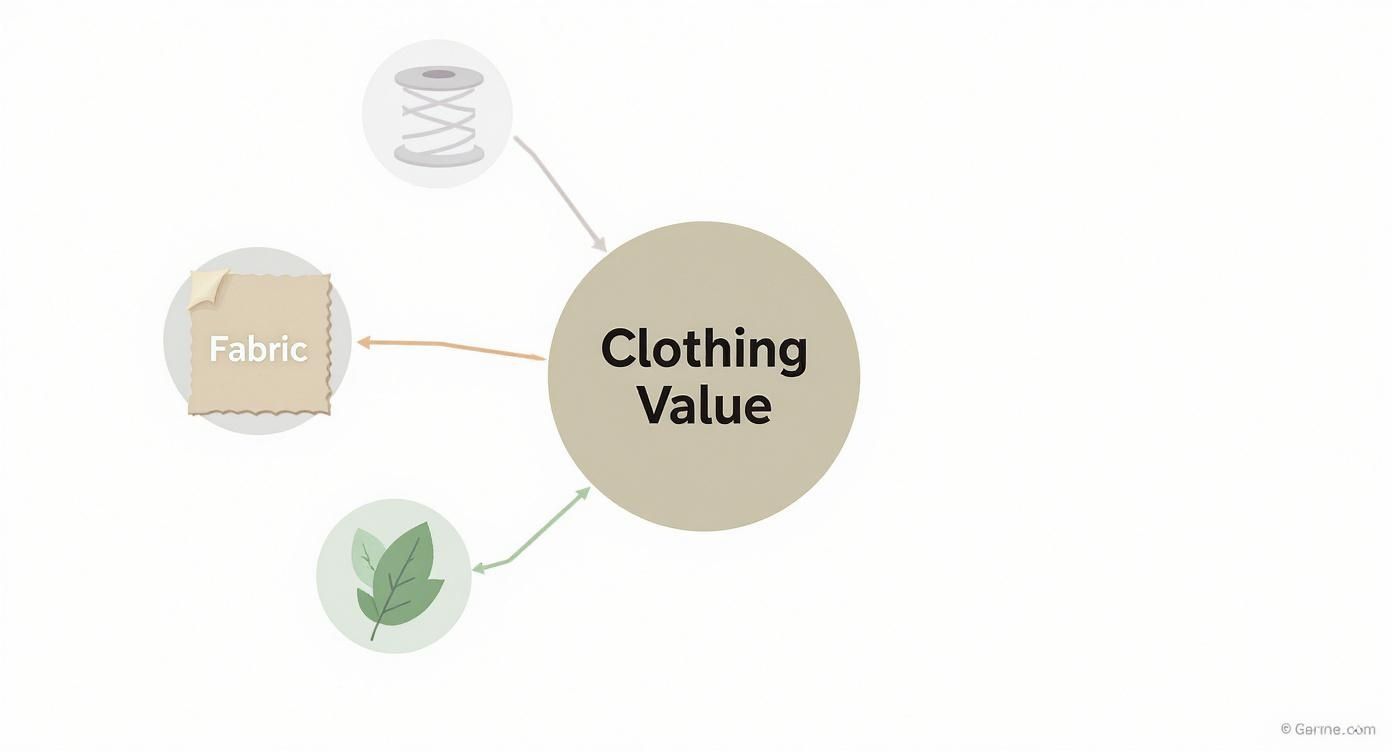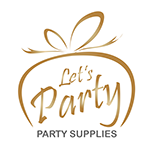
The best quality affordable clothing brands marry sturdy materials with wallet-friendly tags. Think of pieces that feel built to last but won’t leave you hunting for coupons. Brands like Everlane, Uniqlo, and A New Day by Target regularly deliver reliable basics for under $60, proving you don’t have to overspend for something well made.
Best Quality Affordable Clothing Brands Comparison
Here’s a quick breakdown of what to look for when you’re weighing your options:
- Price points range from $20–$60 for everyday essentials up to $80–$200 for standout items.
- Key quality checks include fabric weight, seam finishes, and how well dyes hold up over time.
- Ideal use cases cover everything from weekday tees to eco-friendly wardrobe staples.
On a global scale, the apparel industry clocks in at $1.84 trillion, with 48% of purchases now happening online. For a deeper dive into these apparel market figures, check out the analysis on Dojo Business.
This chart shows e-commerce versus offline market share in apparel.
It highlights that nearly half of all clothing sales now occur online.
Summary Of Top Affordable Brands
Below is a side-by-side look at some leading names in budget-friendly fashion. Use this as a springboard for your next smart purchase.
| Brand | Price Range | Quality Indicator | Best For |
|---|---|---|---|
| Everlane | $50–$150 | Ethical materials, transparent costs | Everyday staples |
| Uniqlo | $20–$80 | Technical fabrics, consistent fit | Daily basics |
| A New Day by Target | $15–$60 | Trend-driven cuts, strong colorfastness | Seasonal refreshes |
| Target’s Universal Thread | $20–$50 | Durable denim and knits | Casual wear |
Use this snapshot to pinpoint which brand aligns with your budget and style needs. Whether you’re stocking up on tees or hunting for denim, these labels offer a clear mix of price, quality, and reliability.
Balancing craftsmanship with cost means fewer replacements and a more sustainable closet.
- Start with a versatile staple—like a tee that holds its shape wash after wash.
- Calculate price per wear to make every dollar count.
Now you’re armed with the key insights to shop confidently among the best quality affordable clothing brands.
Understanding Key Concepts
Think of your wardrobe as a collection of tools: a flimsy shirt is like a dull screwdriver that slips, while a well-made piece feels like a razor-sharp blade cutting through daily wear. Good garments hold their color, shape, and drape for years.
To spot real value, you need to break down each item into its core elements—fabric choice, stitch strength, fit design, and ethical production. Master these, and you’ll shop with confidence.
Fabric And Material Basics
Picture thread count as the mesh in a fishing net. A dense weave means fewer snags and holes. Different weave patterns also give fabrics character and toughness—twill’s diagonal ribs resist tearing and hide dirt better than plain weaves.
Sometimes brands gloss over these details. For a clear look at how some cut-rate labels hide shortcuts, check our guide to what is fast fashion.
- Cotton vs. Polyester Blends: Cotton feels soft and breathes well; polyester adds stretch and dries quickly.
- Linen: Super-absorbent but wrinkles unless blended with another fiber.
- Technical Fabrics: Synthetics designed to wick moisture and fight odor.
Choosing sustainable materials pays off over time. For example, organic cotton fields use crop rotation, so the soil stays healthy and the fabric ages more gracefully.
Stitch Quality And Seam Finishes
Stitches are the mortar in your garment’s brick wall. Even the best “bricks” fail if the mortar crumbles. Inside seams should lie flat with 12–14 stitches per inch—that’s a solid benchmark.
- Flat-felled seams look like double rows of stitching, perfect for heavy or rugged fabrics.
- Reinforced stress points add extra stitching at shoulders, pockets, or side seams.
- Bound seams use a fabric tape over raw edges to prevent fraying.
Strong seams are the unsung heroes of durability.
Run a fingernail across the inside—if fibers catch, expect pilling after just a few washes. Without pinked edges or seam bindings, cuts under jumbo needles can lead to frayed hems almost immediately.
Fit Details And Ethical Manufacturing
A proper fit distributes tension across darts, pleats, and gussets, so no single stitch bears all the stress. Brands that pay fair wages often invest more in skilled operators and well-maintained machines, which translates into better quality.
- Living Wage Practices: Happier workers, well-kept equipment.
- Supply Chain Transparency: Trace fibers back to sustainable farms and eco-friendly dye houses.
- Sustainability Signals: Look for certifications like GOTS or Fair Trade.
- Consumer Feedback: Reviews often reveal how items hold up after many washes.
| Red Flag | Identification Tip | Quality Consequence |
|---|---|---|
| Loose Stitching | Gaps visible under stress points | Seams tear easily |
| Thin Fabric Weight | Sheerness when stretched | Prone to pilling and holes |
| Unfinished Edges | Raw hems on cuffs and collars | Immediate fraying |
| Suspiciously Low Price | Too-good-to-be-true cost | Likely poor materials or labor cuts |
Watch out for these warning signs—they show when speed takes priority over substance. With these fundamentals in mind, every shopping trip becomes a chance to build a wardrobe of lasting pieces. Small decisions around fabric and finish add up to big savings, less waste, and clothes that look—and feel—like new, wash after wash.
Evaluate Fabric And Construction
Great clothing begins with two simple pillars: the material itself and the way it’s stitched. When you learn to spot the telltale signs of quality, you’ll shop with confidence instead of crossing your fingers.
Material Strength And Comfort
Think of fabric as the foundation underfoot in a house. If it’s flimsy, everything above it will show wear.
Before you pick up a garment, run your fingers along the weave. A heavy denim, for example, will feel substantial—resisting tears around the seams—while a lightweight cotton tee might feel soft initially but lose shape after a few washes.
- Cotton offers breathability and that classic, lived-in feel but needs gentle cycles to keep it looking new.
- Polyester Blends bring stretch, resilience, and wrinkle resistance—ideal for pieces that see daily hustle.
- Linen feels like air on hot days but wrinkles unless it’s blended or pressed.
- Technical Fabrics (nylon, spandex) excel at wicking moisture and drying in a snap.
A quick pinch or “stretch test” tells you a lot about texture and weight in seconds. In markets like India, over 70% of consumers rank affordability as the top factor when buying clothes. Learn more about apparel industry trend findings.
You might also appreciate our guide on quick dry clothing for travel to see firsthand how fabric choice affects packability and performance.
Stitching Quality And Finishes
Stitches are the mortar holding fabric panels together. When they stray or unravel, the whole garment is at risk.
Watch for flat-felled seams and tidy, uniform stitch lines in high-stress areas. Then:
- Check for 12–14 stitches per inch on inside seams.
- Pull gently at seam allowances to spot loose threads or gaps.
- Inspect pocket corners and hemming for extra reinforcement.
Clean finishes and secure hems keep fraying at bay and extend each piece’s lifespan.

Simple Hands On Tests
You don’t need fancy tools to judge quality on the spot. A few quick moves reveal fabric weight, density, and colorfastness.
- Density Test: Hold fabric up to light to see how opaque it stays.
- Weight Check: Compare heft by draping a swatch over your fingers.
- Colorfastness Trial: Rub a damp white cloth on a hidden seam to see if dye transfers.
These methods save you trips back to the laundry room.
Before you dive into more details, here’s a handy overview:
Fabric Comparison Guide
A concise look at common fabrics, their price brackets, lifespan, and care needs.
| Fabric | Cost Level | Durability | Care Requirements |
|---|---|---|---|
| Cotton | Low–Medium | Medium | Machine wash, gentle cycle |
| Polyester Blend | Low | High | Machine wash, tumble low |
| Linen | Medium–High | Medium | Hand wash or dry clean |
| Technical Fabric | Medium | High | Machine wash, hang dry |
Keep this chart at your fingertips next time you compare swatches on the shop floor.
Assessing Fabric Durability
Durability means fewer replacements and better value over time. Focus on how cloth holds up in areas that see the most action.
- Look for minimal pilling after several washes.
- Check elbows, knees, or underarms for thinning on knits.
- Stretch a splice of your garment—quality fabric snaps right back.
Spending a little more on tough materials now pays off in time and money saved later.
Evaluating Colorfastness
A richly dyed garment looks sharp longer. Before you commit, test a tucked seam with a damp white cloth.
- No color should transfer when you rub with moisture.
- Hues should stay vivid and fade evenly after repeated laundering.
Brands that share their dyeing methods often stand behind their color warranties.
When fabric and stitching are solid, you’re investing in a wardrobe that won’t quit on you.
Key Takeaways
- Inspect Materials: Feel weight, stretch, and density to judge strength.
- Examine Seams: Uniform, closely spaced stitches mean better construction.
- Test Colorfastness: A quick damp-cloth swipe prevents surprises.
- Use Hands-On Checks: Simple tests are fast, free, and reliable.
With these tactics in your shopping toolkit, you’ll zero in on clothing that feels great, lasts longer, and fits your budget.
Set Your Price Expectations And Budget
Mapping out your clothing budget is like planning a road trip with stops for groceries, gas, and sights. Without those markers in place, it’s easy to blaze through money on momentary trends and impulse buys. By sketching out price brackets first, you’re free to shop confidently instead of second-guessing every cart addition.
- Everyday Basics: $15–$50 per item (tees, leggings, socks)
- Statement Pieces: $50–$120 per item (soft jackets, dresses, shoes)
- Eco Labels: $80–$200 per item for sustainable materials
These simple tiers act as your financial guardrails, steering you away from sticker shock. Plus, they make it easier to shortlist brands that match your budget before you hit “checkout.”
Calculate True Cost Per Wear
Think of cost per wear as the ultimate value meter. A $100 jacket might feel steep until you realize how many times you’ll layer it over a season. By dividing the price by your realistic wear count, you compare apples to apples across garments.
| Item | Price | Wears | Cost Per Wear |
|---|---|---|---|
| Basic Tee | $20 | 30 | $0.67 |
| Denim Jeans | $60 | 60 | $1.00 |
| Blazer | $120 | 50 | $2.40 |
Once you crunch these numbers, you can tweak your price brackets around actual usage and seasonal sale cycles. Plugging figures into a simple tracking template turns guesswork into clear data.
Use Budget Templates And Examples
A straightforward budget divides spending into three streams: everyday essentials, show-stopping pieces, and seasonal updates. This framework keeps your closet balanced and your finances in check.
Allocate your annual budget approximately as follows:
- Everyday Essentials: 50% (tees, jeans, underwear)
- Statement Pieces: 30% (jackets, shoes, dresses)
- Seasonal Updates: 20% (scarves, swimwear, accessories)
For a $1,000 yearly budget, that translates to $500 on basics, $300 on statement items, and $200 on seasonal boosts. Having these percentages mapped out makes decision-making almost effortless.
Track Sales And Leverage Offers
Sale cycles tend to follow the seasons—think mid-July clearances or post-holiday markdowns. Signing up for alerts from your favorite outlets can net you up to 70% off select lines. Layer in cashback apps and you might recover an extra 2–5% on every purchase.
Planning strategic splurges ensures you invest in quality pieces that elevate your wardrobe without derailing your budget.
Set a modest splurge fund, like $100 every quarter, for those must-have finds. Then, revisit your budget twice a year to adjust categories if you’re overspending on basics or underusing trend-driven items.
- Keep a simple spreadsheet or notes app to log purchases.
- Tag each item by category for quick visual checks.
- Compare your actual spend against planned percentages monthly.
These steps turn a loose spending plan into a reliable roadmap toward affordable quality.
Plan For Unexpected Finds
Always carve out a small buffer—around 5–10% of your total budget—for surprise sales or rare one-off pieces. A $1,000 budget, for instance, would set aside $50–$100 for these gems. Over twelve months, those surprise buys can inject character without upending your main spending strategy.
A little planned spontaneity keeps your style fresh and your finances steady.
Logging these unplanned purchases in your budget template helps them feel like treats, not pitfalls. When you combine this with your price tiers and cost-per-wear math, you build a wardrobe that’s both unique and cost-effective.
Shopping Tactics For Quality On A Budget

Finding top-tier clothing on a tight budget can feel like a scavenger hunt—exciting yet unpredictable. A few smart tweaks to when and where you shop can yield big savings on sturdy materials. Suddenly, you’re building a wardrobe full of pieces that last season after season.
Off-season shopping is your first stop. Retailers need shelf space, so they slash prices on classic cuts and quality fabrics—often 50–70% off. Focus on trans-seasonal styles to make the most of these deals.
- Score winter coats in spring.
- Pick up summer linens in the fall.
- Use browser extensions that auto-apply promo codes.
Plan a few months in advance, and you’ll assemble a durable closet without ever paying full price.
Navigate Outlets And Factory Stores
Outlet malls hide some of the best markdowns on familiar brands. Factory stores tucked behind major shopping centers often carry last season’s stock at 30–60% off.
Outlet Shopping Tips:
- Inspect seam finishes for any loose threads or skipped stitches.
- Read material tags to confirm genuine fabric blends.
- Ask about return and exchange policies—these can vary widely.
Frequent trips to outlets can uncover unexpected gems at a fraction of original cost.
Time Holiday Markdowns And Flash Sales
Long weekends like Presidents Day, Memorial Day and Black Friday trigger predictable markdown cycles. Sign up for newsletters early and you’ll get VIP previews or extra coupon codes.
Flash sales move fast—think of them as online auctions where quick reflexes pay off.
Combine holiday events with cashback platforms to reclaim an extra 2–5% on each purchase.
Maximize Loyalty Programs
Retail loyalty tiers reward repeat customers with exclusive perks. A mid-level member might receive a private sale invite days before the general public, and those rewards can add up to over $100 in savings per year.
- Link a rewards credit card to your retailer account.
- Redeem points on big-ticket items for maximum value.
- Stack store coupons with credit card rebates.
These small advantages gradually lower your true cost per wear.
Compare Secondhand Marketplaces
Pre-loved shopping brings designer-quality pieces into reach. Sites like Poshmark, ThredUp and Depop let you browse top labels at steep discounts. Just factor in fees, shipping and return windows before you hit “buy.”
| Marketplace | Pros | Fees | Returns |
|---|---|---|---|
| Poshmark | Large selection, seller ratings | 20% seller fee | Buyer pays shipping |
| ThredUp | Professionally cleaned items | Low listing fee | Free returns within 14 days |
| Depop | Trend-focused sellers | 10% sale fee | Varies by individual seller |
Use this comparison to decide where you’ll land the best secondhand find.
Blend Online And Local Options
Online deals and neighborhood events make a powerful combo. Instagram and Facebook groups often post pop-up sample sales, where you can snag high-end labels at 60–80% off.
- Follow regional fashion communities on social platforms.
- Subscribe to boutique mailing lists for exclusive invites.
- Organize or attend clothing swaps with friends for fresh pieces at no cost.
Mixing digital steals with community trades keeps your style unique and your budget happy.
Leverage Returns And Warranties
Many affordable-quality brands offer extended return windows or repair warranties. Those policies reduce the risk when you’re trying a new label.
- Keep tags and receipts intact.
- Photograph items upon arrival as condition proof.
- Opt for prepaid return labels whenever offered.
This safety net lets you experiment without worrying about commitment.
To effectively find high-quality clothing within your means, it’s beneficial to understand the latest affordable fashion trends for 2025.
You might also find ongoing sale updates helpful by exploring real-time price drop alerts and clearance notifications.
Use these strategies to curate a closet stocked with long-lasting pieces from the best quality—without breaking the bank.
Brand Archetypes And Real World Examples
Think of shopping for clothes like picking players for a championship lineup. Each brand style—fast fashion, heritage, direct-to-consumer, and sustainable—is like a position with its own strengths and quirks.
We’ll walk through four archetypes, spotlight real names, and highlight price ranges, quality signals, and customer feedback so you can zero in on the best affordable options that suit your needs.
Fast Fashion Disruptors
Fast fashion moves runway looks into your cart at lightning speed. You get trendy pieces for almost nothing—but often at the expense of weighty fabrics and reinforced stitching.
Shein has gobbled up 50% market share of U.S. fast fashion, raking in $30 billion each year thanks to breakneck supply chains and rock-bottom prices. Read the fast fashion market share report.
• H&M: Basics at $10–$40. Midweight cotton blends, mixed reviews on longevity
• Zara: Seasonal updates for $30–$70. Moderate weave density, fade reports on washes
• Primark: Ultra-low tags under $20, but often simpler seam finishes
Fast fashion can scratch that style itch quickly. Just inspect the seams and check fabric opacity before you buy.
Heritage Labels And Timeless Quality
These brands are the old pros. Decades of perfecting fabric blends and construction have earned them legendary status.
Levi’s premium denim runs $50–$100 a pair, featuring flat-felled seams and heavy indigo slubs that develop character over time. Ralph Lauren polo shirts sit at $60–$120, thanks to medium-weight cotton, reinforced collars, and lasting color depth.
Quick checks for heritage pieces:
- Count 12–14 stitches per inch for even seams
- Look for tags that mention traceability “ground to rack”
- Spot lifetime or repair warranties as a trust signal
Direct To Consumer Startups
DTC brands cut out the middleman and pass the savings right to you—without skimping on transparency.
Everlane’s wardrobe staples cost $30–$80, complete with full cost breakdowns and GOTS certified cotton you can rely on day in, day out. Quince sells cashmere sweaters at $70 versus typical retail tags near $200, all by shipping straight from factory. KOTN sources Egyptian cotton from farm to front door for $40–$100, and they’re proud to show you the full story.
Tips for vetting DTC:
- Calculate your cost per wear
- Read real-world laundry tests on brand blogs or social feeds
- Confirm their refund and repair policies
Sustainable Innovators
If you care about the planet and durability, these brands lead the way. For a deeper dive, check out our guide to eco-friendly clothing brands.
Sustainable pioneers blend eco-friendly fibers with thoughtful production. Pact’s organic cotton tees at $20–$30 use low-impact dyes and maintain their shape wash after wash. Girlfriend Collective’s activewear begins at $50, spun from recycled bottles and built to last. Outland Denim crafts responsibly sourced jeans at $150, ensuring fair wages and rugged denim that stands up to wear.
| Brand | Price Range | Sustainability Focus | Durability Notes |
|---|---|---|---|
| Pact | $20–$30 | Organic cotton, low dyes | Minimal shrinkage over time |
| Girlfriend Collective | $50–$150 | Recycled materials | Retains stretch and shape |
| Outland Denim | $150 | Fair wages, eco wash cycles | Thick denim resists wear |
Investing in sustainable innovators often means your clothes look and feel new far longer than most fast fashion pieces.
How To Choose The Right Archetype
Match the brand type to what matters most—fast trends, tried-and-true quality, transparent pricing, or eco-responsibility. Here’s a quick way to narrow the field:
- Do you crave constant style updates or pieces you’ll wear for years?
- Is cost transparency or ethical labor more important?
- Are you willing to pay extra for organic or recycled materials?
- Do you need a brand that backs products with repair warranties?
Score each archetype on a 1–5 scale for:
- Trend Agility (fast fashion)
- Craftsmanship (heritage labels)
- Cost Transparency (DTC startups)
- Sustainable Impact (sustainable innovators)
Add up your points, and the highest-scoring archetype will steer your next purchase. Use this framework to shop smarter—and find affordable quality that aligns with your values and budget.
FAQ
When you’re eyeing a wallet-friendly piece, think of the pinch test as the garment’s health check. Pinch the fabric—if it feels dense and snug, you’ve probably found something that can handle everyday wear.
Next, give the seams a gentle tug. Threads that bounce back signal resilience; if they don’t, expect pilling or small tears down the road.
- Fabric Density Pinch Test
- Seam Stretch Rebound
- Colorfastness Wipe Test
Caring for budget fabrics means tweaking laundry basics. Wash in cool water with mild detergent, skip fabric softener, and lay items flat to dry. These steps preserve both shape and color.
On top of that, choose gentle machine cycles and pre-soak stubborn stains with an eco-friendly soap. It’s a small ritual that pays off over dozens of wears.
Care And Longevity
Striking a balance between trends and timeless staples is key. Invest in a sharp-cut blazer or classic denim—and limit yourself to one trend-driven piece each season.
Before you click “buy,” pair new items with three outfits already in your closet. If they mesh, great; if not, move on.
- Keep a mini mending kit on hand for loose buttons or small tears
- Rotate staple pieces monthly to spot early wear
- Replace items only when they fail the pinch or wash test
A small stitch now prevents big tears later.
These FAQs are your roadmap to a smart, durable, budget-friendly wardrobe.
Happy wardrobes combine checks with routine care.
Discover more fashion deals at FindTopTrends: https://findtoptrends.com










